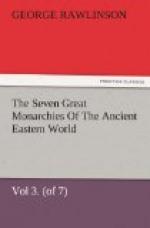powers of the priest-caste—all this together
constituted an imposing whole at once to the eye and
to the mind, and was calculated to give additional
grandeur to the civil system that should be allied
with it. Pure Zoroastrianism was too spiritual
to coalesce readily with Oriental luxury and magnificence,
or to lend strength to a government based on the ordinary
principles of Asiatic despotism. Magism furnished
a hierarchy to support the throne, and add splendor
and dignity to the court, while they overawed the
subject-class by their supposed possession of supernatural
powers, and of the right of mediating between heaven
and man. It supplied a picturesque worship which
at once gratified the senses and excited the fancy
It gave scope to man’s passion for the marvellous
by its incantations, its divining-rods, its omen-reading,
and its dream-expounding. It gratified the religious
scrupulosity which finds a pleasure in making to itself
difficulties, by the disallowance of a thousand natural
acts, and the imposition of numberless rules for external
purity. At the same time it gave no offence to
the anti-idolatrous spirit in which the Arians had
hitherto gloried, but rather encouraged the iconoclasm
which they always upheld and practised. It thus
blended easily with the previous creed of the people,
awaking no prejudices, clashing with no interests;
winning its way by an apparent meekness and unpresumingness,
while it was quite prepared, when the fitting time
came, to be as fierce and exclusive as if it had never
worn the mask of humility and moderation.
CHAPTER V. LANGUAGE AND WRITING.
On the language of the ancient Medes a very few observations
will be here made. It has been noticed already
that the Median form of speech was closely allied
to that of the Persians. The remark of Strabo
quoted above, and another remark which he cites from
Nearchus, imply at once this fact, and also the further
fact of a dialectic difference between the two tongues.
Did we possess, as some imagine that we do, materials
for tracing out this diversity, it would be proper
in the present place to enter fully on the subject,
and instead of contenting ourselves with asserting,
or even proving, the substantial oneness of the languages,
it would be our duty to proceed to the far more difficult
and more complicated task of comparing together the
sister dialects, and noting their various differences.
The supposition that there exist means for such a
comparison is based upon a theory that in the language
of the Zendavesta we have the true speech of the ancient
people of Media, while in the cuneiform inscriptions
of the Achasmenian kings it is beyond controversy
that we possess the ancient language of Persia.
It becomes necessary, therefore, to examine this theory,
in order to justify our abstention from an inquiry
on which, if the theory were sound, we should be now
called upon to enter.




